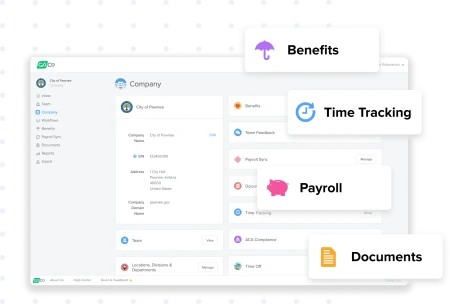Why Your Business Needs an Employee Assistance Program
An employee assistance program (EAP) helps manage stress and other work performance issues.
by Jennifer Kiesewetter - September 9th, 2022
If one thing’s for certain, Americans are more stressed now than in years past. And for good reason. From a global pandemic to rising inflation to continuing supply chain issues, Americans are 20% more stressed than the global average, according to a recent American Institute of Stress study.
Download The State of Health & Safety In HR Report
These stress levels don’t dissipate when Americans head to their workplace – or their home office. Instead, stress naturally pours over into their workdays, directly impacting their engagement and productivity.
Here are some interesting statistics about U.S. workers from the American Institute of Stress Study:
63% want to quit their jobs to avoid work-related stress.
76% claim that workplace stress negatively impacts their personal relationships.
80% claim that ineffective employer communications contribute to workplace stress.
94% feel stressed while working.
And here’s the kicker. According to the University of Massachusetts at Lowell, employee job stress costs employers “more than $300 billion a year in health costs, absenteeism and poor performance.”
Enter the employee assistance program.
With 93% of human resources professionals reporting offering an EAP, 46% of employees claim that their employer does not offer this benefit (or they are unsure if it is offered).
Meanwhile, for every $1 contributed to workplace mental health programs (such as EAPs), employers generally enjoy a return on investment of $4 in better employee health outcomes and productivity, according to the World Health Organization.
Keep reading to learn more about employee assistance programs and how they can benefit your company and employees.
What Is an Employee Assistance Program?
An employee assistance program – or EAP – is an employer-offered benefits program designed to help employees with issues such as stress or burnout that could potentially impact their workplace performance.
EAPs are typically offered alongside other employee benefit plans, such as group health plans, helping employees gain access to employee counseling, assessments, and referrals – all confidentiality. For example, EAPs may include:
Mental health support (such as depression or burnout support).
Substance abuse (such as addiction support).
Family services (such as divorce support).
Physical health services (such as chronic disease management).
Work issues (such as how to navigate a job change).
Financial services (such as budgeting or debt repayment support).
How Do I Offer an EAP to Employees?
So, how do employers offer an EAP to employees? Here are some steps for establishing an EAP for your team.
Learn the basics, such as what your EAP should include for your employees’ benefit.
Understand the EAP delivery models, such as fixed-fee or fee-for-service contracts or small business consortia (where small employers can join together when offering EAP services, helping to lower the cost overall).
Confirm that the EAP providers you’re considering comply with the guidelines established by the International Employee Assistance Professionals Association (EAPA), which address privacy, confidentiality, and monitoring EAP participants along with the recommended policies and procedures to have in place.
When choosing a vendor, consider their years in service; their current clients; their ability to provide services across multiple locations, if applicable; and the hours that employees can access the services – at a minimum.
And don’t forget to communicate this benefit (and its offerings) to your employees. After all, how can your employees take advantage of the EAP’s offerings if they don’t know you offer it or they don’t know how the access it?
By promoting your EAP benefit to your team, you’re helping your employees access employer-provided benefits needed to navigate challenging life issues, boosting EAP usage and improving employees’ personal and professional lives.
What Are the Benefits of EAPs?
Let’s look specifically at how EAPs benefit employees and employers.
For employees
If used, EAP benefits are highly beneficial for employees. In fact, a recent study showed that EAP benefits for employees included:
64% reduced absenteeism
86% increased clinical improvements
86% of increased productivity
94% overall satisfaction with the EAP
Other national and international studies found that EAPs reduce employee stress, improve behavioral health symptoms, and restore improved work functioning.
For employers
Clearly, the employee benefits mentioned above also benefit employers by increasing productivity and reducing absenteeism. However, as human resources professionals know, when building a business case for offering a new benefit, the dollars saved is critical.
Let’s break down the EAP return on investment (ROI) for U.S. employers, based on employer size. According to a recent study, small businesses offering an EAP enjoy a 3:1 ROI. For medium-sized employers offering an EAP, this ROI jumps to 5:1. And, probably not as a surprise, large employers offering an EAP enjoy a 9:1 ROI.
Overall, this study found that cost savings for employers of all sizes saw a cost savings of $2,000 - $3,500 per employee.
In addition to these high ROIs, an EAP can help employees resolve workplace issues, such as negative employee interactions or difficulty managing a worker. By helping managers and leaders learn how to manage conflict within the workplace, EAPs serve as a valuable resource.
Keep in mind, that when employers face conflict within the workplace, they should contact their employment attorney, confirming that their approach satisfies state and federal laws and guidance.
Implementing an EAP for Your Employees
If we’ve learned anything from the last couple of years, it’s that stress takes a toll on both employees and employers. If left unchecked, then retention decreases, and employees start looking for new opportunities with less stress – leaving employers with a revolving door of recruitment.
Helping employees navigate difficult situations with an EAP is a win-win for both workers and companies of all sizes. Want to learn more about how an EAP can benefit your team while delivering an ROI for your organization? Take a tour of GoCo today!

Subscribe to Beyond The Desk to get insights, important dates, and a healthy dose of HR fun straight to your inbox.
Subscribe hereSearch...
Product
GoCo
Resources
Articles
eBooks
Webinars
Customer Stories




